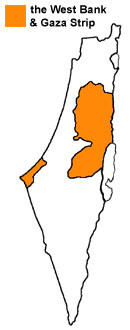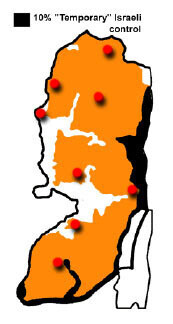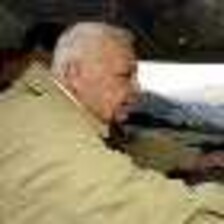The Electronic Intifada 20 March 2002

In a example from an Associated Press report of 20 March 2002, entitled “Gore mixes humor with serious remarks”:
Al Gore mixed self-deprecating humor with a serious call for peace in the Middle East during a keynote speech at a fund-raiser for The Jewish Federation of Greater Los Angeles. Gore told the crowd of about 950 on Tuesday that leaders in the Middle East must step up to end 18 months of Palestinian-Israeli violence. He said the cycle of violence began when Palestinian leader Yasser Arafat rejected an “extremely generous” peace settlement offered by then-Israeli Prime Minister Ehud Barak during the Clinton administration. “We must and will stand by the people of Israel,” Gore said. “We must and will play a constructive role in trying to make it possible for the parties to find a solution.”
This assertion is not credible if the specifics of the Israeli offer are analysed, inspected against the wider context of international law, and — in particular — considering the Palestinians’ own implicit historical offer of land for peace.

1. only proposed to relinquish control over between 77.5-81 percent of the West Bank excluding East Jerusalem, which most likely included Israel’s retaining of the Jordan Valley.2. wanted sovereignty over one-third of occupied East Jerusalem and all of West Jerusalem.
3. wanted control of the third holiest site in Islam, al-Haram al-Sharif (which Israel refers to as the ‘Temple Mount’), where “Israel, incredibly, also demanded Palestinian agreement to the construction of a synagogue.”
Source: “How Generous is Generous?” in CROSSROADS OF CONFLICT: Israeli-Palestinian Relations Face an Uncertain Future, FMEP Special Report, Winter 2000.

The intended result is that an eventual Palestinian state would consist of four cantons on the West Bank: Jericho, the southern canton extending as far as Abu Dis (the new Arab “Jerusalem”), a northern canton including the Palestinian cities of Nablus, Jenin, and Tulkarm, and a central canton including Ramallah.The cantons are completely surrounded by territory to be annexed to Israel. The areas of Palestinian population concentration are to be under Palestinian administration, an adaptation of the traditional colonial pattern that is the only sensible outcome as far as Israel and the US are concerned.
The plans for the Gaza Strip, a fifth canton, are uncertain: Israel might relinquish it, or might maintain the southern coastal region and another salient virtually dividing the Strip below Gaza City.

The Israelis portrayed it as the Palestinians receiving 96% of the West Bank. But the figure is misleading. The Israelis did not include parts of the West Bank they had already appropriated.The Palestine that would have emerged from such a settlement would not have been viable. It would have been in about half-a-dozen chunks, with huge Jewish settlements in between - a Middle East Bantustan. The Israeli army would also have retained the proposed Palestinian state’s eastern border, the Jordan valley, for six to 10 years and, more significantly, another strip along the Dead Sea coast for an unspecified period: so much for being an independent state.
[…]
A genuinely generous offer by Barak might have secured peace. That was the missed historic opportunity. If Israel had been more magnanimous at Camp David, it could have had the greater prize of long-term stability.
There is a huge danger attached to the Israeli view that Arafat spurned a great offer. Accepting this version perpetuates the Israeli myth that the Palestinians will not be happy until the Jews are pushed back into the sea and that the West Bank and Gaza are full of gunmen and bombers intent on making that happen.
There are such people - but most Palestinians are interested less in the destruction of Israel than in establishing a proper Palestinian state. Most are as exercised about the poor quality of the leadership round Arafat and about the endemic corruption and lack of democracy in their own society as they are about Israel. What they want is for the Israeli army to go home and to take the Jewish settlers with them. There will be no peace until that happens.
Source: “The real deal; Ewen Macaskill: Israel’s View That Arafat Missed A Chance For Peace Under Barak Is Dangerously Deluded”, The Guardian, 14 April 2001.
Israeli academic Tanya Reinhart wrote a July 2001 article in Yediot Aharonot, addressing the “massive propaganda about the far reaching concessions which Barak supposedly offered and which the Palestinians rejected.” Reinhart asserted:
“The only clear element of Barak’s plan in Camp David was the immediate annexation by Israel of about 10 percent of the West Bank land. These include the settlement blocks which are close to the center of Israel and in which there are already over 150,000 Israeli settlers. But the bigger fraud of Barak’s plan, which has not received any attention in the public debate, is the fate of the rest of the 90 percent which were supposedly designated to belong to the “Palestinian state”. The situation in these areas is easily visible today: These lands are cut up by 37 isolated settlements which were purposely built in the midst of the Palestinian population to enable future Israeli control of these areas. As a result, 2 million Palestinians are crowded in enclaves which consist of about 50 percent of the West Bank, and the other 40 percents are blocked by the defense array of some 40,000 settlers. As always, unofficial rumors were spread in the media that Israel intends to evacuate these areas in some future. But all relevant government offices clarified repeatedly that no plan is being prepared for the evacuation of even a single settlement. First, the Palestinians need to prove that our imposed arrangements work, and then we will of course discuss and consider.”Source: “Out now! A simple and human step,” by Tanya Reinhart, Yediot Aharonot, 8 July 2001. Originally in Hebrew.
Perhaps the most significant rebuttal of the “generosity” myth was another 8 July 2001 article, this time in the New York Times. Robert Malley, special assistant for Arab-Israeli affairs to President Bill Clinton from 1998 to 2001 and a member of the American peace team at Camp David, identified three “fictions” about the Palestinian failure at Camp David. The latter two of these are highly relevant to the generosity misperception:
Myth 2: Israel’s offer met most if not all of the Palestinians’ legitimate aspirations.Yes, what was put on the table was more far-reaching than anything any Israeli leader had discussed in the past — whether with the Palestinians or with Washington. But it was not the dream offer it has been made out to be, at least not from a Palestinian perspective.
To accommodate the settlers, Israel was to annex 9 percent of the West Bank; in exchange, the new Palestinian state would be granted sovereignty over parts of Israel proper, equivalent to one-ninth of the annexed land. A Palestinian state covering 91 percent of the West Bank and Gaza was more than most Americans or Israelis had thought possible, but how would Mr. Arafat explain the unfavorable 9-to-1 ratio in land swaps to his people?
In Jerusalem, Palestine would have been given sovereignty over many Arab neighborhoods of the eastern half and over the Muslim and Christian quarters of the Old City. While it would enjoy custody over the Haram al Sharif, the location of the third-holiest Muslim shrine, Israel would exercise overall sovereignty over this area, known to Jews as the Temple Mount. This, too, was far more than had been thinkable only a few weeks earlier, and a very difficult proposition for the Israeli people to accept. But how could Mr. Arafat have justified to his people that Israel would retain sovereignty over some Arab neighborhoods in East Jerusalem, let alone over the Haram al Sharif? As for the future of refugees — for many Palestinians, the heart of the matter — the ideas put forward at Camp David spoke vaguely of a “satisfactory solution,” leading Mr. Arafat to fear that he would be asked to swallow an unacceptable last-minute proposal.
Source: “Fictions About the Failure at Camp David,” by Robert Malley, New York Times, 8 July 2001. Accessing article may require registration.
When promoting the Barak ‘generosity’ myth, few seem to consider the profound Palestinian generosity of its own ‘offer’ throughout the peace process since its beginnings at the Madrid talks. In calling for an independent state in the West Bank and Gaza, there is an implicit forsaking of Palestinian soverignty to the parts of 1948 Palestine that lie outside these two areas. Expressed more bluntly, Palestinians have been explicitly negotiating — for a decade now — for a state in just one-quarter of their historic homeland:
Myth 3: The Palestinians made no concession of their own.Many have come to believe that the Palestinians’ rejection of the Camp David ideas exposed an underlying rejection of Israel’s right to exist. But consider the facts: The Palestinians were arguing for the creation of a Palestinian state based on the June 4, 1967, borders, living alongside Israel. They accepted the notion of Israeli annexation of West Bank territory to accommodate settlement blocs. They accepted the principle of Israeli sovereignty over the Jewish neighborhoods of East Jerusalem — neighborhoods that were not part of Israel before the Six Day War in 1967. And, while they insisted on recognition of the refugees’ right of return, they agreed that it should be implemented in a manner that protected Israel’s demographic and security interests by limiting the number of returnees. No other Arab party that has negotiated with Israel — not Anwar el- Sadat’s Egypt, not King Hussein’s Jordan, let alone Hafez al-Assad’s Syria — ever came close to even considering such compromises.
Source: “Fictions About the Failure at Camp David,” by Robert Malley, New York Times, 8 July 2001. Accessing article may require registration.
To conclude, the actual amount of land in Israel’s offer was far from “generous” in Palestinian eyes, its implementation would have compounded the current problems with freedom of movement, and it also did not meet the minimum requirements of UN Security Council Resolutions or international legal precepts concerning the disposition of territories occupied during war. For more information on this last point, see How Oslo promoted human rights violations on this site.
In addition, Palestinians have long been making the most generous concession possible to make to a foreign colonial power — that of sharing their land with the colonisers.
The following section offers an account of the reaction of the Palestinian Authority’s Negotiation Support Unit in April 2001 to Barak’s offer at Camp David.
The view of the Palestinian Authority’s Negotiation Support Unit
At a 6 April 2001 Center briefing for the Center for Policy Analysis on Palestine in Washington D.C., Omar Dajani, Amjad Atallah and Nisreen Haj-Ahmad — legal advisors to the Palestinian Negotiation Support Unit — challenged the popular perception of Barak’s offer.
Omar Dajani stated that Palestinians want viability, independence, and choice, all of which were missing from Barak’s proposals.According to Dajani, viability involves “development potential and [territorial] contiguity.” This would result in more “predictability,” allowing Palestinians to make arrangements for travel and the transfer of goods without worrying about checkpoints and closures. This element of predictability has been absent under occupation, resulting in a “tremendous psychological” and “economic cost.” Barak’s offer disregarded these concerns. It would have led to Palestinian islands in East Jerusalem within a “sea” of Israeli settlements and Israeli annexation of land all the way to Jordan.
The Palestinians’ shortage of water resources and agricultural land was neglected by Barak’s proposals. Annexation of “large swaths of the territory” over the Western Aquifer would increase Israel’s proportion of water under international law, thus reducing the Palestinians’. This aquifer primarily lies under West Bank land and is the “best” and “most abundant” Palestinian water source. As for their agricultural needs, the only area left for development is the Jordan Valley, which Israel sought to keep under long-term lease.
On the topic of independence, the Palestinians asked Israel to “cede overriding authority” over air, water, and other key issues, to them. Israel was willing to recognize Palestinian “sovereignty” in these areas, but wanted to maintain overriding control.
On Dajani’s third point, he said the “dominant feature” of refugee life has been “an absence of choice.” Some refugees may choose to stay in Jordan, some may choose third country resettlement, some may move to the Palestinian state, and some may wish to return to their homes in what is now Israel, but he argued they must have a choice.
Amjad Atallah then discussed how the current crisis arose. The first Intifada ended not because the Declaration of Principles (DOP) was signed, but because of the promise that within five years, final status issues would be settled, there would be Palestinian statehood, and the situation would gradually improve along the way. Yet the “opposite” has occurred. For example, Palestinians were led to believe that settlement building would cease or at least lessen, but the settlement population doubled since Oslo.
The “Israeli presence and the occupation” intensified. Settlements and settlement roads “bisected” the West Bank into dozens of sections. There is “less freedom of movement” now than before the signing of the Declaration of Principles.
Add to this Israel’s decision to “wean” itself from Palestinian labor, and “you have an economy that [was] collapsing” even before the Intifada. The current closures are “the nails in the coffin of the economy.”
In addition, Israel has ignored interim agreements-the release of Palestinian prisoners and the third stage of redeployment have not occurred. By two and a half years ago, Israel should have withdrawn from 90 percent of the West Bank. Instead, the PA controls just 18 percent of it.
Some have asked Atallah: But why now? Atallah’s answer is this: The deal at Camp David was put forward as a “take it or leave it” offer. As a result, the Palestinians on the street believed that this deal was the final offer-it was the best they would get. They believed the peace process was over. Then came Ariel Sharon’s visit to the Haram al-Sharif with “over 1,000 [members of the] Israeli occupation forces” and Israel’s use of live ammunition against Palestinian protesters the next day. The Intifada erupted in response.
Nisreen Haj-Ahmad outlined a proposal to restart negotiations, arguing that the United States needs to recognize “the reasons behind the Intifada.” It will not end “without [the offer of] an alternative.” She outlined four components of a Jordanian-Egyptian proposal that has been passed on to the U.S., the EU, and indirectly, to Israel:
Sharm el-Sheikh II should be implemented. This would include the cessation of the Intifada in return for Israel withdrawing its tanks and ending the closure imposed on the Occupied Territories.
Israel and the Palestinians should implement agreements signed thus far. This would help to address the causes of the Intifada and could help “restore the belief” of Palestinians “in the process.” Israel’s obligations would include the implementation of the third further redeployment, a commitment to the land-for-peace equation, and a “stop to settlement activities.” For the PA, this would mean that “security cooperation would resume” and they would continue the collection of weapons.
The Israelis and Palestinians should begin “parallel talks.” The first track would involve discussion on previous interim talks to clarify what the two parties had agreed to, and the second track would focus on permanent status talks that would be “comprehensive and final.”
Third-party “monitoring of implementation” of “the commitments of both sides” should commence.
One audience member asked if nonviolent confrontation has been seriously considered. Atallah said that “there’s been an attempt to move to nonviolent popular demonstrations.” Although they have not received much coverage, these actions are “well organized and well attended,” “even when stone-throwing is not allowed.”
Atallah referred to the March demonstration in Birzeit to reopen the blockaded roads. Attendees were diverse, including Atallah; Hanan Ashrawi, Palestinian Legislative Council member; Mustafa Barghouthi, director of the Health, Development, Information, and Policy Institute; and Tanzim leader Marwan Barghouti. Potential stone-throwers were literally held back-they were picked up, put in ambulances, and driven away. This was successful until Israeli soldiers lobbed tear gas canisters, the group scattered, and some children found an opportunity to throw stones. The army then opened fire with live bullets.
Source: The above section “The view of the Palestinian Authority’s Negotiation Support Unit” in this article is an edited version of “Limitations of the Camp David Proposal, Roots of the Intifada, and Possibilities for Change,” For The Record, Number 69, 7 March 2001, CPAP.
Related links:




